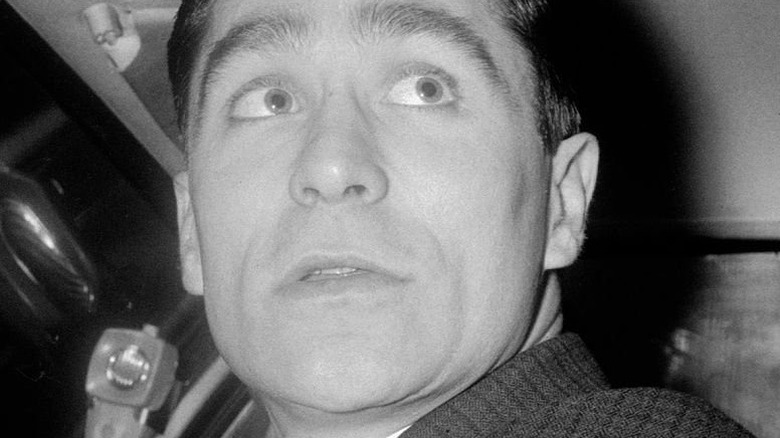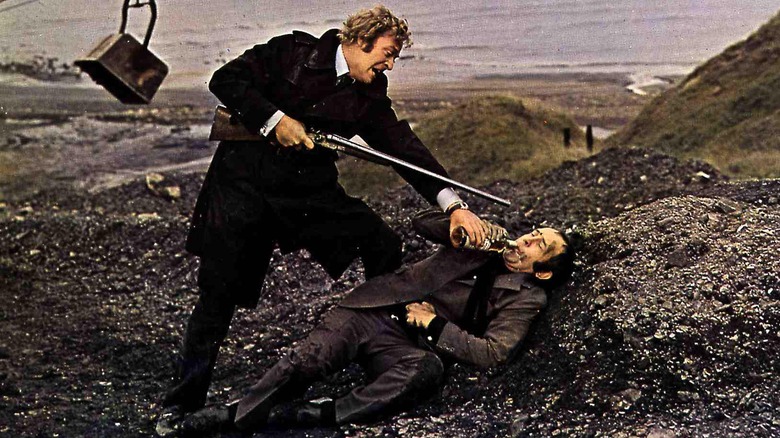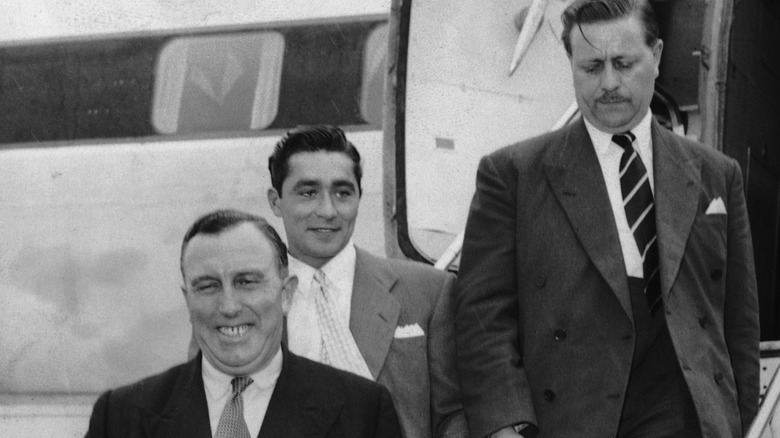Murderer Dennis Stafford Partially Blames Michael Caine For His Bad Reputation
The ”One-Armed Bandit” murder sent shockwaves through the North of England when the news first broke on the front pages of the tabloids on a bleak January morning in 1967. Many who feared organized crime's growing stranglehold on England in the late 1960s would feel a lump in their throat after hearing about this terrible murder (per BBC).
Angus Sibbet, 33, was discovered dead and bloodied in the backseat of his bullet-riddled Jaguar Mark 10 by the railway tracks of South Hetton. To many, this heinous crime bore all the hallmarks of a merciless gang hit, a phenomenon that was all too typical in Britain at the time. "Silent, calm, and deep / both dead and cold / shot through with bullet holes" Mark Knopfler would later sing in his 2004 song "5:15 am", a reflection on how this murder affected the local working-class community. The song was titled after the time Sibbet's body was discovered by a terrified miner on his way to work in the early hours of January 5th.
This homicide was so shocking that it permeated pop culture in many ways, inspiring a bestselling novel and later spawning a film adaptation of the novel, bringing this brutal crime to the forefront of the public consciousness.
Two months after Sibbet's body was discovered, two of his associates, Vince Luvaglio and Dennis Stafford, were prosecuted, tried, and convicted for his murder, despite both men vehemently professing their innocence. They were only released 12. years later, in 1979, but they would spend the rest of their lives attempting to clear their names and uncover the truth about this terrible murder (per The Northern Echo).
Dennis Stafford would subsequently blame Michael Caine in part for the difficulties he experienced in clearing his name, but why?
Michael Caine Enters the Picture
Four years after their conviction, Luvaglio and Stafford found themselves in front of the Court of Appeals, maintaining their innocence and denouncing police corruption. This appeal however, would be unsuccessful. Meanwhile in British cinema, the 1971 gangster picture ”Get Carter," starring Michael Caine and set in and around Newcastle and County Durham (where the killing took place), would be released to the public, courting controversy and sparking a debate about violence in working-class areas.
While the relationship between movies and real-life violence has always been complex and contentious, a debate that may seem banal to us in the 21st century, one must consider the context in which the British public interpreted and took to heart the violence of these late 1960s gangster films.
The gritty realism of "Get Carter" and unflinching depiction of working-class violence would have undoubtedly shocked many when it was released in the late 1960s, especially since its source material, the novel ”Jack's Return Home," was directly and openly inspired by The One-Armed-Bandit murder (via BBC). The debate surrounding this violence, as well as Northern England's fears of a deadly criminal underground carrying up with the Northern winds to carve out new turf, would have played perfectly into the anxieties of many working-class viewers.
Stafford himself would allegedly tell Britain's Daily Mail, "Michael Caine charging round on-screen blasting away with a shotgun hardly helped my case." Caine himself admitted that his portrayal of a down-to-earth, albeit colder, gangster was intended to erase the cartoonish aspects of gangster characters at the time (via The Gentleman's Journal).
It's hard to believe that ”Get Carter” alone could have altered the public's perception of ordinary working-class men, like Stafford and Luvaglio, being capable of murder. The reality of the situation is that Stafford's bad reputation stems from a variety of other reasons.
Stafford's Pre-Existing Bad Reputation
Although Stafford's remark is perhaps intended to be more tongue-in-cheek than anything, one has to ask; How deserving was Stafford of his bad reputation in the first place? Stafford didn't exactly have a reputation as a choirboy before his fateful entanglement with the Angus Sibbet murder, having already run afoul of the law several times before 1967, and having previously served convictions for illegal firearm possessions, jailbreaks, and business fraud in Newcastle (via Youtube).
Even after his release from prison for his role in the One-Armed-Bandit murder in 1979, Stafford continued to fall back into his old habits, earning two more stints in jail for breaching his parole conditions in 1989, and for an ill-fated traveler cheque scam in 1994 (via BBC). ”I was a crook, I freely admit it,” Stafford allegedly told the Daily Mail in 2008, ”but I was never a killer." Although such an extensive rap sheet would undoubtedly influence the public's perception of Stafford as an innocent man, he continues to maintain that he was framed and that the murder was carried out by a hitman instead (according to The Northern Echo).
Although the truth of this grisly murder may never be known. One thing is for sure; Michael Caine's role in the tale is merely that of art mirroring life, and as the saying goes, before pointing fingers, one should make sure their hands are clean first.


